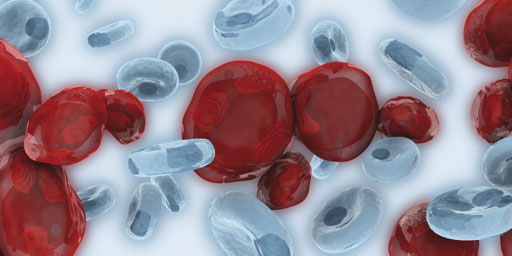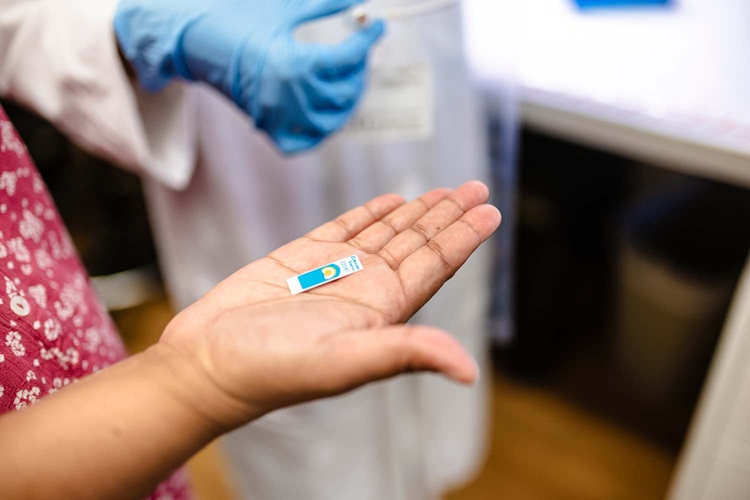Unique Assay Improves Cancer Diagnosis for Leukemia Patients
|
By Michal Siman-Tov Posted on 13 Dec 2016 |

Image: The new CALR RGQ PCR Kit tests for calreticulin (CALR) mutation to aid in diagnosis of myeloproliferative neoplasms (MPN), and is QIAGEN’s latest addition to its ipsogen portfolio of assays for hemato-oncology testing (Photo courtesy of QIAGEN).
A new CE-IVD-marked assay for calreticulin (CALR) mutations, run on a well-established RT-PCR platform, aids in establishing the diagnosis of myeloproliferative neoplasms (MPN) in line with the latest WHO recommendations and clinical guidelines.
The new ipsogen CALR RGQ PCR Kit (ipsogen CALR assay) from QIAGEN N.V. (Hilden, Germany) is intended for detection of CALR mutations in genomic DNA from patients suspected of MPN. It enables identification of the two majors CALR mutations, Type 1 and Type 2, and detects additional mutations in the CALR exon 9 region. The ipsogen CALR assay simplifies CALR testing by covering various relevant mutations to deliver multiple clinical results within one working day.
The test runs on QIAGEN’s QIAsymphony and Rotor-Gene (RGQ) platforms, employing the CE-IVD-marked Rotor-Gene Q MDx 5Plex HRM Platform real-time cycler with automated analysis and interpretation using the Rotor Gene AssayManager software. QIAsymphony is a highly flexible, widely available platform for medium throughput molecular testing. Throughput flexibility is achieved by DNA sample processing from peripheral blood using either the manual QIAamp DSP DNA Blood Mini Kit or the automated sample processing on the QIAsymphony SP instrument.
The new ipsogen CALR RGQ PCR Kit is synergistic with the CE-IVD-marked ipsogen JAK2 RGQ PCR Kit, QIAGEN’s leading solution to detect the V617F mutation in the janus kinase 2 (JAK2) gene, as CALR mutations can be detected from the same patient sample.
The ipsogen CALR assay is the latest addition to QIAGEN’s ipsogen portfolio of assays for both common and rare leukemia types. MPN are a group of blood cancers characterized by significant symptoms and complications such as thrombosis (blood clots) and a high risk of transformation into acute leukemia. MPN include polycythemia vera (PV), essential thrombocythemia (ET), and various forms of (primary) myelofibrosis (PMF). MPN affect nearly 250,000 patients in Europe and 300,000 patients in the US. The combined annual incidence rate for MPN worldwide is roughly 2.5 in every 100,000.
“We are excited to announce the launch of our new ipsogen CALR assay to help improve and facilitate patient diagnosis of MPN. The CALR assay is a very important addition to QIAGEN’s market leading ipsogen portfolio of molecular assays that are advancing treatment standards for patients with blood cancers,” said Dr. Christoph Menzel, director Global Product Management Personalized Healthcare and Oncology, QIAGEN, “We strongly believe our IVD Sample to Insight workflows for biomarkers such as CALR and JAK2 will make it easier for hemato-oncologists to follow recommended diagnostic testing algorithms and international guidelines.”
The importance of CALR mutations in MPN was first described in December 2013 in two important papers published in the New England Journal of Medicine (Klampfl T et al, and Nangalia J et al). Earlier in 2016, mutations in CALR were included in addition to JAK2 mutations as a major diagnostic criterion for MPN in the updated WHO guidelines for the classification of myeloid neoplasms and acute leukemia. Both CALR and JAK2 V617F mutations were recently described in clinical guidelines to have prognostic significance.
Related Links:
QIAGEN
The new ipsogen CALR RGQ PCR Kit (ipsogen CALR assay) from QIAGEN N.V. (Hilden, Germany) is intended for detection of CALR mutations in genomic DNA from patients suspected of MPN. It enables identification of the two majors CALR mutations, Type 1 and Type 2, and detects additional mutations in the CALR exon 9 region. The ipsogen CALR assay simplifies CALR testing by covering various relevant mutations to deliver multiple clinical results within one working day.
The test runs on QIAGEN’s QIAsymphony and Rotor-Gene (RGQ) platforms, employing the CE-IVD-marked Rotor-Gene Q MDx 5Plex HRM Platform real-time cycler with automated analysis and interpretation using the Rotor Gene AssayManager software. QIAsymphony is a highly flexible, widely available platform for medium throughput molecular testing. Throughput flexibility is achieved by DNA sample processing from peripheral blood using either the manual QIAamp DSP DNA Blood Mini Kit or the automated sample processing on the QIAsymphony SP instrument.
The new ipsogen CALR RGQ PCR Kit is synergistic with the CE-IVD-marked ipsogen JAK2 RGQ PCR Kit, QIAGEN’s leading solution to detect the V617F mutation in the janus kinase 2 (JAK2) gene, as CALR mutations can be detected from the same patient sample.
The ipsogen CALR assay is the latest addition to QIAGEN’s ipsogen portfolio of assays for both common and rare leukemia types. MPN are a group of blood cancers characterized by significant symptoms and complications such as thrombosis (blood clots) and a high risk of transformation into acute leukemia. MPN include polycythemia vera (PV), essential thrombocythemia (ET), and various forms of (primary) myelofibrosis (PMF). MPN affect nearly 250,000 patients in Europe and 300,000 patients in the US. The combined annual incidence rate for MPN worldwide is roughly 2.5 in every 100,000.
“We are excited to announce the launch of our new ipsogen CALR assay to help improve and facilitate patient diagnosis of MPN. The CALR assay is a very important addition to QIAGEN’s market leading ipsogen portfolio of molecular assays that are advancing treatment standards for patients with blood cancers,” said Dr. Christoph Menzel, director Global Product Management Personalized Healthcare and Oncology, QIAGEN, “We strongly believe our IVD Sample to Insight workflows for biomarkers such as CALR and JAK2 will make it easier for hemato-oncologists to follow recommended diagnostic testing algorithms and international guidelines.”
The importance of CALR mutations in MPN was first described in December 2013 in two important papers published in the New England Journal of Medicine (Klampfl T et al, and Nangalia J et al). Earlier in 2016, mutations in CALR were included in addition to JAK2 mutations as a major diagnostic criterion for MPN in the updated WHO guidelines for the classification of myeloid neoplasms and acute leukemia. Both CALR and JAK2 V617F mutations were recently described in clinical guidelines to have prognostic significance.
Related Links:
QIAGEN
Latest Molecular Diagnostics News
- STI Molecular Test Delivers Rapid POC Results for Treatment Guidance
- Blood Biomarker Improves Early Brain Injury Prognosis After Cardiac Arrest
- Biomarkers Could Identify Patients at High Risk of Severe AKI After Major Surgery
- CLIA Test Identifies Head and Neck Cancer Recurrence from Post-Surgical Lymphatic Fluid
- New 15-Minute Hepatitis C Test Paves Way for Same-Day Treatment
- Ovarian Cancer Assay Outperforms Traditional Tests in Early Detection
- Ultrasensitive Method Detects Low-Frequency Cancer Mutations
- Blood Test Enables Non-Invasive Endometriosis Detection
- New Blood Biomarkers Help Diagnose Pregnancy-Linked Liver Complication
- Simple Urine Test to Revolutionize Bladder Cancer Diagnosis and Treatment
- Blood Test to Enable Earlier and Simpler Detection of Liver Fibrosis
- Genetic Marker to Help Children with T-Cell Leukemia Avoid Unnecessary Chemotherapy
- Four-Gene Blood Test Rules Out Bacterial Lung Infection
- New PCR Test Improves Diagnostic Accuracy of Bacterial Vaginosis and Candida Vaginitis
- New Serum Marker-Editing Strategy to Improve Diagnosis of Neurological Diseases
- World’s First Genetic Type 1 Diabetes Risk Test Enables Early Detection
Channels
Clinical Chemistry
view channel
POC Breath Diagnostic System to Detect Pneumonia-Causing Pathogens
Pseudomonas aeruginosa is a major cause of hospital-acquired and ventilator-associated pneumonia, particularly in lung transplant recipients and patients with structural lung disease. Its ability to form... Read more
Online Tool Detects Drug Exposure Directly from Patient Samples
Doctors often rely on patient interviews and medical records to determine what medications a person has taken, but this information is frequently incomplete. People may forget drugs they used, take over-the-counter... Read moreHematology
view channel
MRD Tests Could Predict Survival in Leukemia Patients
Acute myeloid leukemia is an aggressive blood cancer that disrupts normal blood cell production and often relapses even after intensive treatment. Clinicians currently lack early, reliable markers to predict... Read more
Platelet Activity Blood Test in Middle Age Could Identify Early Alzheimer’s Risk
Early detection of Alzheimer’s disease remains one of the biggest unmet needs in neurology, particularly because the biological changes underlying the disorder begin decades before memory symptoms appear.... Read more
Microvesicles Measurement Could Detect Vascular Injury in Sickle Cell Disease Patients
Assessing disease severity in sickle cell disease (SCD) remains challenging, especially when trying to predict hemolysis, vascular injury, and risk of complications such as vaso-occlusive crises.... Read more
ADLM’s New Coagulation Testing Guidance to Improve Care for Patients on Blood Thinners
Direct oral anticoagulants (DOACs) are one of the most common types of blood thinners. Patients take them to prevent a host of complications that could arise from blood clotting, including stroke, deep... Read moreImmunology
view channel
Blood Test Could Identify Colon Cancer Patients to Benefit from NSAIDs
Colon cancer remains a major cause of cancer-related illness, with many patients facing relapse even after surgery and chemotherapy. Up to 40% of people with stage III disease experience recurrence, highlighting... Read moreBlood Test Could Detect Adverse Immunotherapy Effects
Immune checkpoint inhibitors have transformed cancer treatment, but they can also trigger serious immune-related adverse events that damage healthy organs and may become life-threatening if not detected early.... Read moreMicrobiology
view channel
Breakthroughs in Microbial Analysis to Enhance Disease Prediction
Microorganisms shape human health, ecosystems, and the planet’s climate, yet identifying them and understanding how they are related remains a major scientific challenge. Even with modern DNA sequencing,... Read more
Blood-Based Diagnostic Method Could Identify Pediatric LRTIs
Lower-respiratory tract infections (LRTIs) are a leading cause of illness and death worldwide, and pneumonia is the leading infectious cause of death in children under five, claiming the lives of over... Read morePathology
view channel
Rapid Low-Cost Tests Can Prevent Child Deaths from Contaminated Medicinal Syrups
Medicinal syrups contaminated with toxic chemicals have caused the deaths of hundreds of children worldwide, exposing a critical gap in how these products are tested before reaching patients.... Read more
Tumor Signals in Saliva and Blood Enable Non-Invasive Monitoring of Head and Neck Cancer
Head and neck cancers are among the most aggressive malignancies worldwide, with nearly 900,000 new cases diagnosed each year. Monitoring these cancers for recurrence or relapse typically relies on tissue... Read more
Common Health Issues Can Influence New Blood Tests for Alzheimer’s Disease
Blood-based tests for Alzheimer’s disease are transforming diagnosis by offering a simpler alternative to spinal taps and brain imaging. However, many people evaluated at memory clinics also live with... Read more
Blood Test Formula Identifies Chronic Liver Disease Patients with Higher Cancer Risk
Chronic liver disease affects millions worldwide and can progress silently to hepatocellular carcinoma (HCC), one of the deadliest cancers globally. While surveillance guidelines exist for patients with... Read moreTechnology
view channel
Machine Learning Models Diagnose ALS Earlier Through Blood Biomarkers
Amyotrophic lateral sclerosis (ALS) is a rapidly progressive neurodegenerative disease that is notoriously difficult to diagnose in its early stages. Early symptoms often overlap with other neurological... Read more
Artificial Intelligence Model Could Accelerate Rare Disease Diagnosis
Identifying which genetic variants actually cause disease remains one of the biggest challenges in genomic medicine. Each person carries tens of thousands of DNA changes, yet only a few meaningfully alter... Read moreIndustry
view channel
BD and Penn Institute Collaborate to Advance Immunotherapy through Flow Cytometry
BD (Becton, Dickinson and Company, Franklin Lakes, NJ, USA) has entered into a strategic collaboration with the Institute for Immunology and Immune Health (I3H, Philadelphia, PA, USA) at the University... Read more








 (3) (1).png)











